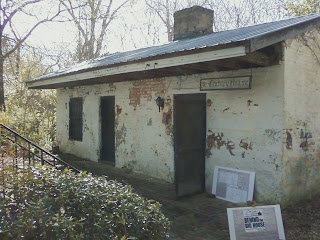I was in Holly Springs during the Pilgrimage a few years ago. I remember it was pouring rain and we -- Carlton, his mother and me -- were in and out of the car, stopping to visit and walk through a series of very large antebellum homes, occasionally posing on a rain-slick veranda for a photograph. All of the well preserved homes were furnished in antebellum splendor. I remember very white-skinned young women in period costume -- ribbons and huge skirts and gloves and lace -- standing around like nervous "set" pieces.
I knew nothing about Holly Springs at the time except that it was where Carlton had grown up, his father the first black mayor of this small town in Mississippi.
The field trip I remember most clearly was Corydon, IN and watching the glassblowers.
It's mostly walking between and inside very old houses. There are booths around the town square but I think they are a more recent addition. The Pilgrimage is staged by the Holly Springs Garden Club, a group of elderly white women descended from the oldest families; the Tourism Board collaborates as excited albeit subordinate partner.
I didn't visit a single mansion this year. My participation in Pilgrimage 2013 was as an enthusiastic, committed volunteer to the Back of the Big House (BTBH) tour. The Back of the Big House tour is a narrative that augments and legitimizes the story told in the Pilgrimage tour. As I described it to visitors, "The people who built the big house and maintained it's lawn and hand-stitched the gorgeous hoop skirts by hand did not live in the big house. They lived in a smaller house. Behind the big house."

Holly Springs etiquette culture required the sponsors of BTBH, the nonprofit group Preserve Marshall County and Holly Springs, Inc. (PMCHO) to request clearance/permission to happen from the Garden Club. This was, perhaps, in large part because the slave dwellings that make up the BTBH tour sit adjacent to the big houses of the Pilgrimage tour.
Of the six extant slave dwelling sites currently under the protection of PMCHO, four were open to the public. The photo is taken at the McCarroll Place on the first work day (described in a previous post found here). I was deeply moved by the possibility that the dirt on my hands that day had been dirt on some other hands a century earlier; and that I toiled freely in a space where others had worked in bondage.
I took this picture on Saturday morning during my shift at the McCarroll Place. The weather was beautiful. Perhaps because McCarroll sits further from the center of town than the other sites, or perhaps because a mistake on the map led visitors to the wrong street, there were no tourists that morning. I spent the time alone, watching insects and birds and squirrels go about their usual routines. I heard several new bird songs, including an unidentified species that sang what I think was a diminished A minor chord with such precision I thought someone was hiding in the surrounding forest and playing a trick on me.
I might have stayed at McCarroll all day except there were no bathroom facilities and I finally had to make my way home.
There are, unfortunately, no pictures or video or audio clips of the BTBH event at Christ Church midday Friday. Following the Garden Club- sponsored organ recital by Ms. Phil Brown on the historic instrument there, a BTBH program featured a brief musical performance (by me on the baby grand) and a lecture by Justin Rogers on "Spirituality and Religion in Slave Culture."
A sweet surprise was making the acquaintance of Ms. Rebecca Bourgeois that morning during my shift at the Craft House quarters. Rebecca is, among other things, a trained vocalist. She consented to sing the first song of my program, "When This Cruel War is Over" though she was unfamiliar with the song and we had not rehearsed. We pulled it off beautifully. The second piece was my arrangement of "Were You There When They Crucified My Lord". I closed the musical portion of the program with The Ashokan Farewell. My talking points for the BTBH debriefing is a firm suggestion that we document the entire BTBH tour next year.
---------@@@@---------
This post is a quick-sketch overview of the tour, mainly for my records. I'll share deeper reflections in the next post.
